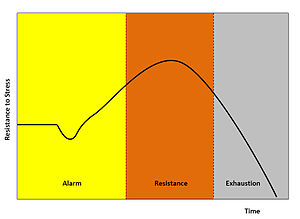一般適應綜合症
一般適應綜合症(英文:general adaptation syndrome, GAS),也稱一般適應症候群,為加拿大心理學家漢斯·薛利(Hans Selye)於1930年代定義的一類適應性反應:一個有機體必須尋回他的平衡或穩定,從而維持或恢復其完整和安寧[1]。

分類
編輯一般適應綜合症包括三個階段:報警階段、抵抗階段和疲憊階段[2][3][4]。
- 報警階段(Alarm):在一個短暫的生理喚醒期中,軀體能夠有效行動並做好準備。如果應激源仍然保持,機體則會進入抵抗期。
- 抵抗階段(Resistance):機體可以忍耐並抵抗長時間的應激源帶來的衰弱效應。
- 疲憊階段(Exhaustion):若應激源持續時間長或持續強度大,機體則因資源消耗而進入疲憊期。
相關條目
編輯參考文獻
編輯- ^ Hans Selye, History of the Stress Concept. Ch. 2 in Leo Goldberger and Shlomo Breznitz Handbook of Stress: Theoretical and Clincal Aspects. Free Press, 1982
- ^ Selye, Hans. Diseases of adaptation. Wisconsin medical journal. 1950, 49 (6): 515–6. PMID 15431657.
- ^ Selye, Hans. A syndrome produced by diverse nocuous agents. Nature. 1936, 138: 32. doi:10.1038/138032a0.
- ^ "Selye Biologic Reaction to Stress chart" (頁面存檔備份,存於網際網路檔案館), Chronic Fatigue Unmasked, by Dr. Gerald E. Poesnecker, February 1999 (ISBN 0916285618)
| 這是一篇與心理學及精神疾病相關的小作品。您可以透過編輯或修訂擴充其內容。 |